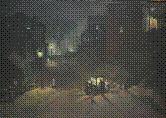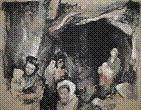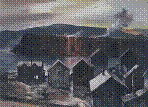The
following description has been prepared entirely by the current owner, Roberts
S. Fastov, Esq., and, at the collector’s request, has not been edited by Sloans
& Kenyon
Note 1) Gaertner, who specialized in
industrial and industrially related scenes, such as this work, was very
prominent in his day, as is made clear by the following biographical materials,
which are taken from the Askart.com website:
"The following biography is
from Christine Fowler Shearer, Arts Administrator, Massillon Museum, Massillon,
Ohio. She is the former Director of the Cleveland Artists Foundation, which has
two paintings by Carl Gaertner in the collection.
Carl Gaertner was born in Cleveland
on April 18, 1898. He graduated from East Technical high school in 1918 and
attended Western Reserve College. In high school he studied mechanical design,
but by his senior year had decided to make painting his primary avocation. From
1920 to 1923 he studied at the Cleveland School of Art (now the Cleveland
Institute of Art) with Henry Keller. In 1922, he entered his first May Show at
the Cleveland Museum of Art and won second prize for an industrial oil
painting. From 1925 until 1952, he taught studio classes at the Cleveland
School of Art and occasional classes at John Carroll University, Western
Reserve University and the John Huntington Polytechnic Institute.
The reflective eye of Gaertner
chronicled three decades of Cleveland and its people. It is all there: the
growing might of industrial Cleveland; the mass-produced promise of the
assembly line, giving way to a dawning awareness of lost freedom, and the
surrender of individuality; the love affair of Americans with nature and the
ideals of Thoreau and Whitman and Frost; and the conflict between that love
affair and the industrial promise.
Gaertner's subject matter was always
drawn from the world around him. Early in his career, he focused on Cleveland
and its environs. This interest never left him, but as he matured, his choice
of subjects broadened. He painted watercolors and oils of Bermuda in the mid
1920's and began making frequent trips to Provincetown in 1926. Like other
Cleveland artists, he culled inspiration from travels within the United States,
notably trips to Pittsburgh and Cambridge Springs in Pennsylvania, to the
mountains of West Virginia, and to Cape Cod. From the mid 1940's until his
death, he also produced paintings based on sketches made during train rides to
visit galleries in New York City.
At the time of his premature death
in 1952, Carl Gaertner enjoyed a considerable reputation as a master of
American Scene painting. By the 1940's, Gaertner was represented by the Macbeth
Gallery in New York City and his paintings were exhibited in shows throughout
the United States. In 1944 and 1952, Gaertner received the National Academy of
Designs highest award for individual work in a group exhibition. Prestigious
institutions, including the Cleveland Museum of Art and the Metropolitan Museum
of Art, had begun acquiring his paintings. But since the artists sudden death
from a brain hemorrhage at age 54, his reputation has fallen into relative
obscurity."
Per Askart.com, Gaertner’s work is
in a number of prestigious museum collections, including the Whitney
Museum of Art (NYC, NY), Pennsylvania
Academy of the Fine Arts
(Philadelphia), Smithsonian
American Art Museum (Washington, D.C.), Allen
Memorial Art Museum (Oberlin, Ohio), Butler
Institute of American Art
(Youngstown, Ohio), Cleveland
Artists Foundation (Cleveland, Ohio), Colby
College Museum of Art (Waterville, Maine), Museum
of Art at Brigham Young University
(Provo, Utah), Springville
Museum of Art (Springville, Utah), Canton Museum of Art (Canton, Ohio), Columbus Museum-Georgia, Detroit
Institute of Arts (Detroit Michigan and Toledo Museum of Art (Toledo, Ohio).
Note
2) The foregoing very impressive Gaertner biographical information; the fact
that this painting is a well-executed crisply painted realistic landscape of scrubland;
is an interesting composition, which has very vivid coloring and staccato-like
brush work; is esthetically appealing; in good condition; and attractively
framed and the following auction records regarding Gaertner sales warrant the
conclusion that the presale estimate of $1,500-$2,000 is reasonable and
justifiable. The highest auction price ever paid for a Gaertner work of art was
$170,000 on 10/24/2009.
Title/Subject:
Mess Tent, 1952 Signed and dated. Gouache on board. 11.75 in. x 17 in. sold
for $1,500 on 05/08/2010 at Rachel
Davis Fine Arts, Cleveland, OH
Title/Subject:
Winter Street Scene Signed. Oil on artist's board. 7 in. x 9 in. sold for
$5,500 on 10/23/2010 at Rachel Davis Fine Arts, Cleveland, OH
|
||||||||||||||||||||||||||||||||||||||||||||||||||||||||||||||||||||||||||||||||||||||||||||||||||||||||||||||||||||||||||||||||||||||||||||||||||||||||||||||||||||||||||||||||||||||||||||||||||||||||||||||||||||||||||||||||||||||||||||||||||||||||||||||||||||||||||||||||||||||||||||||||||||||||||||||||||||||||||||||||||||||||||||||||||||||||||||||||||||||||||||||||||||||||||||||||||||||||||||||||||||||||||||||||||||||||







